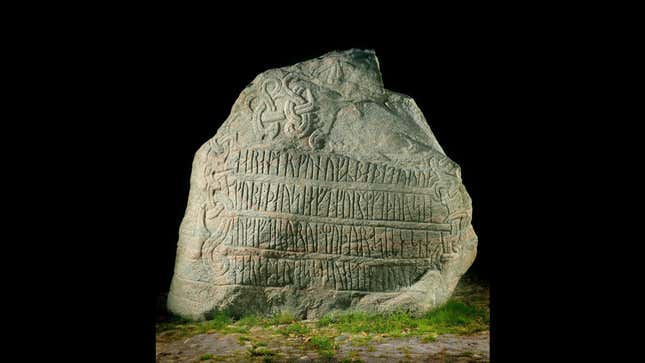
Archaeologists scrutinizing two groups of runestones from Denmark have determined the name ‘Thyra’ mentioned in the two inscriptions refers to the same woman: Queen Thyra, wife of Gorm the Old, and mother of Harald Bluetooth, the ruler whose name adorns the technology that connects modern wireless devices.
Vikings were seafarers, traders, and raiders that settled across northwestern Europe in the 8th through 11th centuries. They traveled as far as North America by 1021, as cosmic rays in tree rings revealed a millennium later. Earlier this year, archaeologists found the footprints of a large Viking hall in Denmark, north of the recently studied runestones.
The two groups of stones are known as the Jelling and Ravnunge-Tue stones; the first group is named after the royal site in Jutland on which they sit, and the second is named after their carver. But in addition to emphasizing the power Thyra wielded in 10th-century Denmark, the new research also suggests that Ravnunge-Tue incised the runes in both sets of stones. The study is published this week in Antiquity.
“We wanted to see if we could find the same rune carver on some of these stones, so that we could connect the Ravnunge-Tue stones with the Jelling stones” said Lisbeth Imer, an archaeologist at the National Museum of Denmark and the study’s lead author, in an Antiquity release. “If there was a connection, it would be highly likely that all the stones referred to the same woman, Thyra, mother of Harald Bluetooth.”
The Ravnunge-Tue stone that mentions Thyra (the Læborg Stone) reads: “Ravnunge-Tue carved these runes in memory of Thyra, his queen.” But according to the Viking Ship Museum, the term “queen” could have also applied to a wife or mistress, and Thyra was a relatively common name at the time. “So maybe it was just the case that Tue was married to a Thyra,” the museum website states.

Bluetooth was the son of Thyra and Gorm the Old, and king of Denmark in the mid-10th century. Bluetooth brought Christianity to Denmark and unified Norway and Denmark in 958. According to Bluetooth’s corporate website, Harald had a bluish-gray dead tooth, hence the name.
Though ‘Bluetooth’ was meant to be a temporary code name for the short-range wireless technology while it was under development, it stuck, and the Younger Futhark runes that make up Harald Bluetooth’s initials (ᚼ and ᛒ) were combined to make the technology’s logo.
The archaeologists 3D-scanned the inscriptions to study the shape of the runes and the carving techniques used to make them. They also compared the historic runestones with runes carved by modern stoneworkers, to better understand how the inscriptions may have been made.
The team concluded that one of the Jelling stones and one of the Ravnunge-Tue stones were carved by the same person; therefore the ‘Thyra’ mentioned on those stones was likely one and the same.
“No other Viking man or woman in Denmark has been mentioned on that many runestones,” Imer said, “and it underlines her undeniable importance for the assembling of the realm under the rule of her son, Harald Bluetooth.”
Thyra, the researchers posit, may have been one of the key figures in the making of modern Denmark, given that her importance was enough to justify mention on multiple runestones. The Jelling stones were raised by Bluetooth, so perhaps the king just really loved his mom.
It would be some coincidence if Ravnunge-Tue also loved (or was involved with) a Thyra distinct from the woman he was commissioned to honor with a runestone. So it seems like Queen Thyra, mother of Bluetooth, was a pretty big deal in Viking-era Denmark.